You are using an out of date browser. It may not display this or other websites correctly.
You should upgrade or use an alternative browser.
You should upgrade or use an alternative browser.
a Valkyrie Rises Over Europe, a Alternate Story of the Cold War
- Thread starter Kaiser K
- Start date
so this is TTL version of the Maracanazo(Madridazo?) of the favourite host being defeated as local at the same end? wow, simple wow?
with the reich is out of profesionals sports? protesting about something or what?
The Reich is out of profesionals sports for now. By the late 50's, ealry 60's, they, Italy, Finland, and other Axis nations will be back, and tear the US a new one, or at least the UK.
Why aren't the Germans playing?
Are they protesting that "non-Aryans" are playing in FIFA or what?
Yes. That would be the case here. Specifically the inclusion of the Soviet Union in both the '52 and '56 World Cups as well as the corresponding Olympic Games. As a result of said inclusion of the Soviets in these events. the Germans (as well as the majority of the Tripartite Pact) have constantly refused to participate in Officially Sanctioned FIFA and IOC competitions up to this point.
And have done no worse then third in the others.
Girl Power fuck yeah!
so this is TTL version of the Maracanazo(Madridazo?) of the favourite host being defeated as local at the same end? wow, simple wow?
Wow, nice spot there man. You are very correct. This is pretty much in a nutshell TTL's version of the Maracanazo Event.
The Reich is out of professional sports for now. By the late 50's, ealry 60's, they, Italy, Finland, and other Axis nations will be back, and tear the US a new one, or at least the UK.
You are correct as well. The Reich (and the other Axis nations that followed Berlin's boycott) will be back probably in or by 1960. And possibly be as good if not better then ever
Through one correction. Finland did participate in both sets of Olympics and World Cups. They faced the United States in the '56 Semi-Finals actually.
What become of the Polish 1st Armoured Division? Ben L. Salomon? And the international jewish community?
Also, what was FDR thinking during the war before his death?
Reasking, if that's all right.
Premiering on the AH.com Network Tomorrow
a Valkyrie Rises over Europe: Chapter 15
All's Quiet on the Transylvanian Front
I can't wait!!
But up next, eight straight hours Space Bat Pawn Stars followed by Return to War: the St. Patrick’s Day Raids.Premiering on the AH.com Network Tomorrow
a Valkyrie Rises over Europe: Chapter 15
All's Quiet on the Transylvanian Front
Looking forward to seeing how this next update plays out.
Premiering on the AH.com Network Tomorrow
a Valkyrie Rises over Europe: Chapter 15
All's Quiet on the Transylvanian Front

=======
PART 15
All's Quiet on the Transylvanian Front
PART 15
All's Quiet on the Transylvanian Front
In hindsight. It can truthfully be said that the middle years of the 1950's were one of the more turbulent times of the entirety of the Cold War. A time of political upheaval. Increasing tensions and diplomatic games as the world suffered through the transition into the New World Order that had been established in the aftermath of the Second Great War.
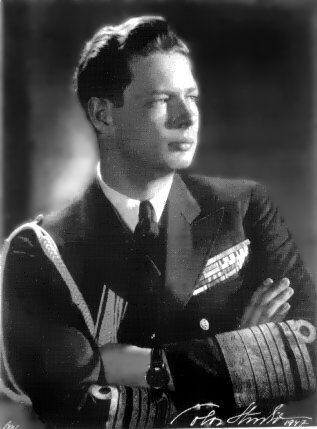
Figure 1: Michael I, The King of Romania. Michael was one of the instrumental figures behind the 1956 Hungarian-Romanian War
The murders of the 20 young Romanian student-protesters in Oradea, Hungary that occurred on July 21, 1956 were largely the culmination of a long string and series of events that occurred the years leading up to the events of that day between the Hungarian and Romanian governments that ultimately led to the breakout of war between their respective countries. As discussed in extensive detail already. This string of events largely stemmed from the "Transylvanian question" and both countries respective and competing claims over the entirety of the region. A question which itself in turn stemmed from the long standing and bitter relations that Hungarians and Romanians had historically held since the Middle Ages and the days of the old Hungarian Empire; Transylvania historically being a battleground and point of mutual contention for the Magyar and Romanian peoples. These historical and long standing tensions, only further aggravated as a result of policies practiced by the governments of both countries during the early years of the Cold War meant that any attempt to keep a peace rapidly became doomed to ultimately fail in the long term. As such, many modern historians who look back upon the conflict largely share the belief that it was something that was going to inevitably break out one way or another. With the Oradea Massacre merely providing the right excuse at the right time for King Michael and the Romanian government to push through a formal declaration of war against the Hungary.
The initial movements of the war proved to be slow on the other hand; compared to the fast buildup that lead to it. The Carpathian Mountains that lined the majority of the Hungarian-Romanian border proved to be a daunting obstacle in both sides attempts at large scale military operations against the other's armies. Nonetheless. The Hungarian Army was able to mount a large scale push into Southwestern Romania; capturing the cities of Arad and Timișoara before being halted by the Romanian Eighth Army slightly north of Lugoj. Denying the Hungarians the chance to capture the city. Which served as a crucial transportation and supply hub for the Romanian Eight, Sixth and Twelfth armies; all of which were operating within the area. The fighting in the Carpathian Mountains was on the other hand limited compared to the larger scale fighting in the southwestern plains. With the ground fighting being mainly contained to small scale border raids by specialized and elite mountain forces as both countries armies struggled to conduct operations in and along the tough terrain of the Carpathian. The fight in the skies over the Carpathian was however extensively more active compared to the situation on the ground; with the forces of the RHAF (Royal Hungarian Air Force) and the RRAF (Royal Romanian Air Force) battling for dominance over the skies of the mountains.
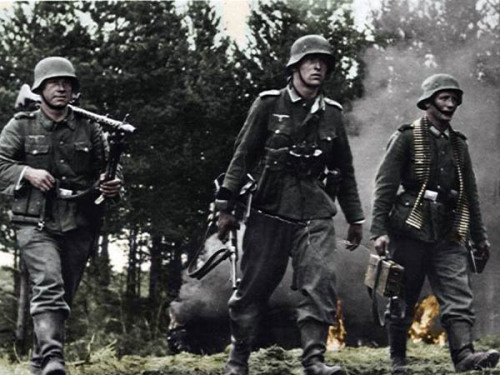
Figure 2: German troops patrol the Romanian countryside during "Operation: Golden Dawn". German troops would not see any actual combat during the Operation due to the abrupt end of it brought on by the Hungarian surrender.
While the sons of the flowing Danube fought and died on the ground and in the air for their respective governments; The collective mood regarding the conflict several hundred miles away from the battlefields of the Carpathian sung a very different tune. This "tune" of course being the one of timid and cautious concern expressed by the German government regarding the conflict. The Germans as a whole were heavily invested in maintaining the continental status quo that it had successfully established in Europe in the aftermath of it's victory in the Second Great War; using whatever means were necessary to preserve said status quo. In addition to protecting the Reich and her "allies" against any and all deemed a direct or indirect threat to the continent. While the conflict between Romania and Hungary was not in the traditional sense a threat to the Reich; it nonetheless served as a potential catalyst to destabilize the entirety of the Tripartite Pact. And thus German dominance on the continent. Of course; we must not forget that German motivations about the conflict (as briefly explained before) were actually in large part due to the Reich's concerns regarding the oilfields of Ploesti. Which at the time of the Hungarian-Romanian War were the Reich's most reliable source of petroleum. Thus the German government ( feared that the conflict would find it's way south. Destabilizing or otherwise causing irreparable damage to Ploesti. Which would potentially have grievous effects on Germany long term.
As a result of these concerns. The German government quickly decided that a formal intervention into the conflict would be necessary to protect the Reich's security. As well as it's commercial interests in the region (including protecting Ploesti from any and all damage). The Germans were helped by the fact that their military was already on high alert status due to ongoing insurgency in the Eastern Territories. Allowing them to quickly mobilize and prepare their forces (250,000 men strong. In addition to 2 full Panzer Armies) for the operation; To ensure quick and rapid success. Albert Speer decided to personally appoint Field Marshal Feodor von Bock as overall commander of the forces allocated to the intervention. Speer; who was a close friend of the Field Marshal. Trusted his skill and ability in battle greatly and personally saw him as the perfect commander to lead the operation. Bock and his forces moved towards the border between the Reichskommissariat Ukraine and Romania and prepared their positions on the 9th of August. After receiving the confirmation that Berlin had informed the Romanian government of the Reich's intentions to assist them in their war against Hungary. Bock and his forces subsequently moved forward with Operation: Golden Dawn. Crossing the border into the country at approximately 2:14 AM local time on August 10th. Beginning a swing westwards to help reinforce the RRA's position on the frontlines in the Carpathians and southwestern Romania. A smaller contingent of 5,700; of which included the 3rd SS Panzer Division "Wolgaburg". Moved south from Krakau to link up with elements of the Slovak Army near the Slovak-Hungarian border. And prepared for a planned southward assault on Budapest.
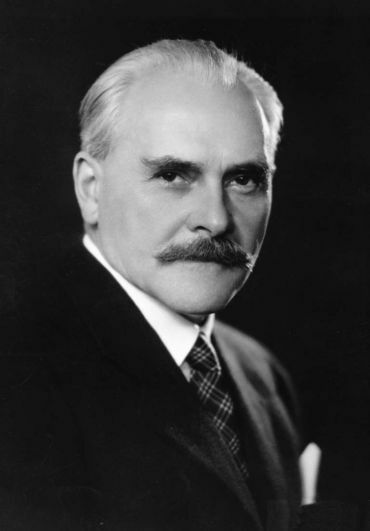
Figure 3: Miklós Kállay, Prime Minister of Hungary during the Hungarian-Romanian War. He was forced to resign after the conclusion of the War by King Paul. Replaced by Döme Sztójay
That assault would never have occur however. As the Hungarian government; faced with the threat of German invasion from every direction. Formally conceded to the Germans demand for ceasefire with Romania and agreed to meet in Bratislava to discuss peace. After several months of negotiation. The Treaty of Bratislava; signed on October 29th, 1956. Formally ended the Hungarian-Romanian War. The treaty's terms forced Hungary to pay 15 million forints to the Romanian government as reparation payments for the damage caused during the short but damaging war. In addition to these payments. The Hungarians were forced by Germany to grant autonomy to Northern Transylvania as another concession to Bucharest. While the treaty was seemingly harsh when looked at from the outside. At it's core it was merely a enforced return on the part of the Germans to the status quo of the pre-war. Through one that was favored towards Romania in the end. Thus as a whole. One may look at the peace made that day in Bratislava in a certain objective and nuanced way. Since the treaty in question may have formally ended the conflict. But as history would later show. It would certainly not end the bad blood that had resulted in the war occurring in the first place.
Western involvement in the conflict was relatively non-existent due to the localized nature of it within Europe. Especially as you consider the fact that ACT's "reach" and ability to conduct operations in Eastern Europe were fairly limited compared to what they could do in the West. Thanks in large part to the fewer contacts that they had in Eastern Europe compared to their vast array of contacts and allies in the western half of the continent. The fact that Hungary and Romania were surrounded by the Reich itself also did not help ACT's chances of influencing the situation at all.

Figure 4: The above is a campaign poster from Senator Estes Kefauver's 1956 campaign for president. Despite his best efforts. Kefauver would go on to lose the election to incumbents Stassen and Lodge come November.
Speaking of the West. Specifically the United States in this case. Underwent a collective national mood swing as a result of the United States unexpected upset victory in the FIFA World Cup over host country and favorite Spain. The victory was a crowning moment of glory that Americans could just celebrate; something they could just cherish and take in. Allowing them to forget about the trials and tribulations of the disconcerting national and even more troubled international politics. Even if it was just for a day. Of course; this feeling would not last for long. Soon the focus was back on politics, specifically the upcoming 1956 Presidential Election. Incumbent President Harold Stassen and Vice President Lodge would unsurprisingly be easily nominated for a second full term with only minimal opposition from within the Republican Party. The Democrats in turn nominated Tennessee Senator (and the 1952 Vice Presidential nominee) Estes Kefauver; who subsequently chose Virginian Senator Clarence Potter as his running mate. When compared to the relative landslide that was the previous election four years prior; the 1956 election would end up being a more highly contested battle for the President. This was in large part due to the Recession of 1955 that had stunted the relative economic boom of the post war years; seeing a general rise in the unemployment rate to 11.0% by November of 1956. The President was also partly hurt as a result of rumors (which may or may not have been spread by Kefauver and the Democrats) that circulated in the months prior to the election that he was having a affair with his Personal Secretary. These hits however would in the end not deter Stassen/Lodge from easily defeating Kefauver/Potter come November; and thus a second full term in the White House.
While the great political gambit was played in America. A greater gambit was being played in North Africa. The Free French; led by General (and now President) Charles De Gaulle had retreated to the "safety" of their African colonies as a result of the German takeover over mainland France during the Second Great War (which later would of course result in the formation of Vichy France). The colonies; specifically Algeria. Had already been growing increasingly weary with the dominance over their lands held by European powers in the years before and during the War. Growing increasingly nationalistic as time went on. This general growth of nationalistic and anti-European feeling would only be further aggravated by the retreat of De Gaulle and the Free French to Africa proper. Especially as it became clear that the French would not be going back to "metropolitan France" any time soon. While several pro-independence organizations had existed in the years prior to, during and after the war. The right wing "Algerian National Council" (CNA) quickly rose to prominence during the mid 1950s. Establishing itself as the leader of the Algerian Resistance movement.
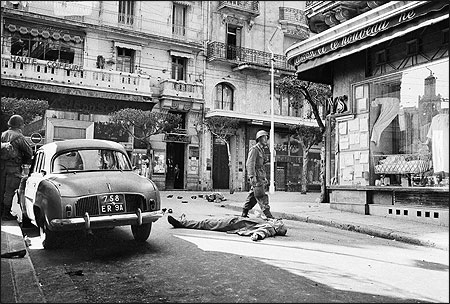
Figure 5: The aftermath of a Resistance Attack on Algiers that occurred on October 16th, 1956. The attack claimed the lives several French civilians. including two young children and a pregnant woman.
The CNA's actions had been fairly docile and non-violent since its formation in 1949. The majority of any action by the group consisting of non-violent protests and demonstrations throughout the territory, most of which ended in the arrest of the protesters by the French police. This would, however, change greatly on September 8th, 1956, when several CNA militants planted a makeshift explosive device at Algiers City Hall. The resulting explosion killed 22 people, all of whom were employees of French origin and blood. The Bombing of City Hall would, unfortunately for the French, only be the beginning. Over the course of the next four months, 26 separate attacks occurred all across French Algeria. These attacks were mostly localized bombings at locations that saw high civilian traffic, or locations that were otherwise important French establishments. For example, the French Cultural Center in Oran, which was the target of such an attack in October of 56. As the attacks by the CNA escalated. The members of ACT; especially the United States grew increasingly concerned that De Gaulle's government would be forced out of the country or collapse all together due to the efforts of local nationalists. Leaving a power vacuum that would leave Algeria vulnerable to the ever extending and influential claws of the Valkyrie (rightfully so however. Considering the Algerian National Council's openly right wing political leaning. In addition to the various connections with prominent fascist parties in Europe that the CNA had). As a result of the developing situation in Algeria. The ACT Security Council was promptly forced to convene for a unscheduled emergency meeting at it's headquarters in London on Christmas Day, 1956. The meeting, which lasted over the course of a 4 day period. Resulted among other things. In the members of ACT formally pledging to support De Gaulle and Free France in their fight against the forces of fascism and oppression in whatever way they could.
Unfortunately for ACT. Their support for the Free French would not be the only support anyone in Algeria would be getting. The developing situation in Algeria was looked upon with great intrigue by the German government. Despite the fact that Arabs (of which included Native Algerians) were technically untermensch according to National Socialist racial science and ideology. The Germans; Especially Speer himself saw the growing Fascist leagues and groups that existed across the Middle East and North Africa as potentially useful allies against ACT (In fact. The German government had actually by the late months of 1956 established ties with several prominent right-wing and fascist organizations in the region. Including the Syrian Social Nationalist Party and the Tunisian National Socialist Council). The German high command saw the ACT-allied Free France as a dagger pointing directly at the throat of Axis control in the Mediterranean. A dagger that needed to be promptly removed. The CNA's rise and the growing crises in Algeria soon gave the Germans exactly what the needed to remove such dagger. Deciding that it was time to give one Benyoucef Ben Bella a offer he couldn't refuse.
Last edited:
And there she is. Just need to add our good natured photos and we're all good
I'd watch that show...
The game is heating up I would say.
No they won't....
But up next, eight straight hours Space Bat Pawn Stars followed by Return to War: the St. Patrick’s Day Raids.
Looking forward to seeing how this next update plays out.
I'd watch that show...
The game is heating up I would say.
Hungary will won over Romaina!
No they won't....
As the timeline goes further and further, how are you going to show pictures of German soldiers? I don't think you can keep using WWII pictures at some point and not break the suspension of disbelief that the German military hasn't changed its appearances or equipment at all. However, there are obviously not any pictures of a plausible Nazi looking German army farther than 1945 since the East German and West German armies looked nothing like the Wehrmacht.
As the timeline goes further and further, how are you going to show pictures of German soldiers? I don't think you can keep using WWII pictures at some point and not break the suspension of disbelief that the German military hasn't changed its appearances or equipment at all. However, there are obviously not any pictures of a plausible Nazi looking German army farther than 1945 since the East German and West German armies looked nothing like the Wehrmacht.
That is honestly a good question. The obvious and quickest solution would be of course to not to show pictures of anything German (unless I can find a really convincing substitute). But that would also be wrong to my readers readers. As I would basically be shutting out everything from Germany and not allow them to see the growth of the German state in picture because of the issue of not having the right pictures. Since the Nazi state obviously did not last this long in OTL. Finding anything plausibly Nazi looking post-45 is almost impossible.
It's really the biggest problem I am facing right now to be honest. I honestly have no idea how I am going to handle the issue when I get to the point that I can't realistically use WW2 pictures anymore.
I may have a solution to this problem.
Use pictures of the West-German Bundesgrenzschutz.
Like these?

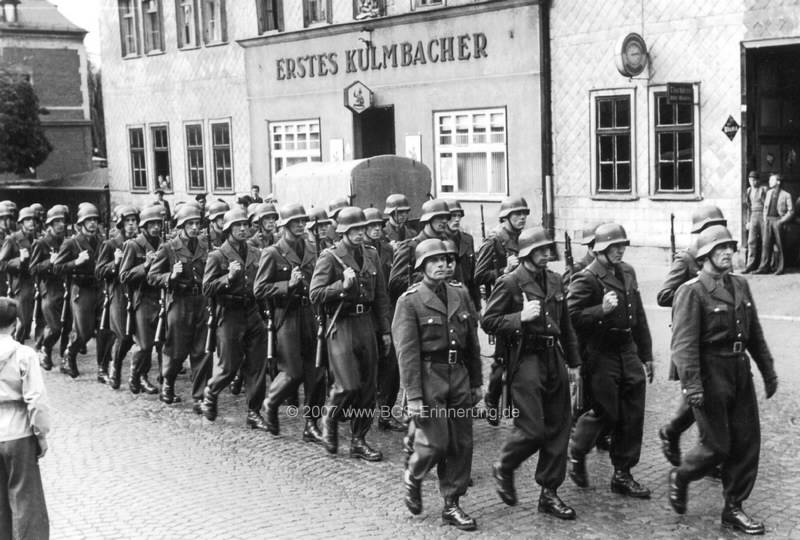
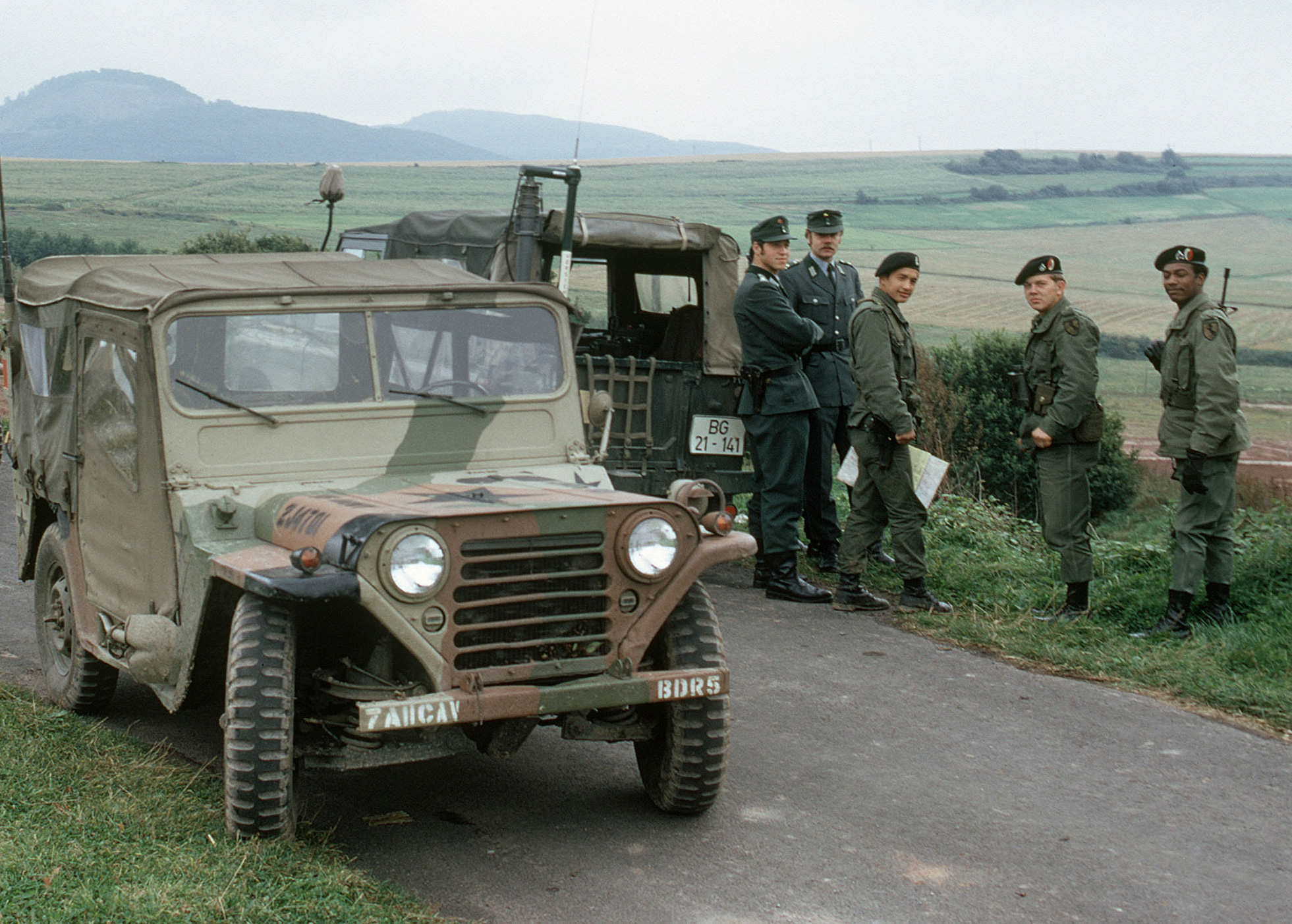
take out the black man, and it should work.
Luckily for you, Kaiser K, most modern helmets generally look like Stahlhelms because of their superior protective shape.
Maybe the Austrian armed forces? They were stuck with Hugo Boss surplus for quite some time.
Also, looks like I backed the right horse.
Maybe the Austrian armed forces? They were stuck with Hugo Boss surplus for quite some time.
Also, looks like I backed the right horse.
Good update. The Free French will have a lot on their plate. Speer is playing an effective diplomat for a world superpower. He was the right choice for Führer if Germany wanted to stabilize post-war. Himmler would have probably wanted to start another war as soon as possible, to expand Germany even more.
Nice Clarence Potter mention.
Nice Clarence Potter mention.
Well the '56 election went as expected. Seeing as I don't think Stassen will go for (or win) a third full term, I wonder who will lead America through those far off 1960's? I'm going to guess LBJ, Symington, or Humphrey.
Anywho, a good update, and with bad blood still between Hungary and Romania it'll be interesting to see if another spark ever makes the two come to blows again. Also, sucks to be Free France at the moment.
Anywho, a good update, and with bad blood still between Hungary and Romania it'll be interesting to see if another spark ever makes the two come to blows again. Also, sucks to be Free France at the moment.
Share: